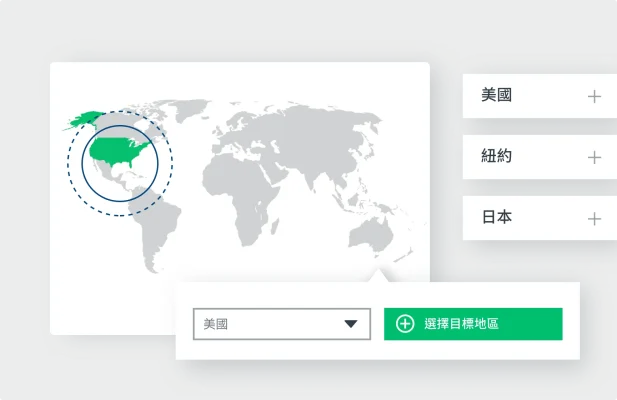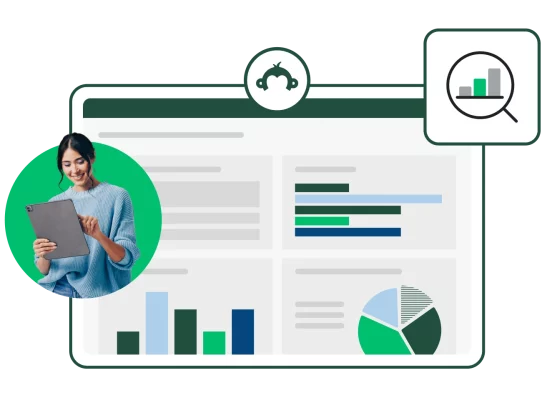五大類市場區隔及運用方法 (附範例)

- 市場區隔是將廣闊的消費者市場按照一個或數個共同的特點分類,以劃分為較小、彼此不同的群體。
- 市場區隔之重要性在於,它讓企業能夠有效鎖定特定的群體,進而提升客戶滿意度並和業績。
- 最常見的五種市場區隔變數包括人口統計變數、心理統計變數、行為變數、地理變數和企業統計變數。
您可以把客戶想像成一幅色彩繽紛的馬賽克作品,每個客戶都獨一無二,但彼此之間又交織著些許相似之處。市場區隔就是從這當中找出規律、按照客戶的共同特徵將他們分類,並根據不同客群的需求和願望打造有效策略的一門藝術。
透過市場區隔區分不同客群之後,企業就能更有效地針對這些不同的客群設計廣告。由於每個客群都會有自己的喜好,使他們與眾不同,因此企業可以藉由迎合他們的喜好來提升參與度、創造更多互動並提升銷售量。
何謂市場區隔?
市場區隔是根據特定的共同因素,將一個廣大的群體區分成數個子群體的過程。每個子群體的內部共通點可能是某個人口統計特徵 (年齡、性別等)、地理位置、態度或行為,或數個特點的集合。
透過將市場分成若干個具有共同特性的較小群體,我們才能針對不同目標受眾做出精準有效的決策。
您知道您的目標市場有哪些特徵嗎?
只要幾分鐘,讓 SurveyMonkey 消費者區隔解決方案幫助您找到答案。
為什麼要做市場區隔?
市場區隔的目標是讓企業能夠詳細瞭解每個細分市場的特性。一旦明確定義出不同的細分市場後,行銷人員就能夠針對最有可能購買的潛在客群打造行銷策略。
為了達到目標,行銷人員會透過下面三個步驟來釐清特定群體的組成,以及他們購買產品的原因。
- 區隔:根據某些共同特徵將市場劃分成數個類別。
- 鎖定:選出最有可能購買其產品的細分市場,做為目標市場。
- 定位:行銷人員必須研究出怎樣的產品、價位、推廣方式和通路最能吸引目標市場來購買其產品。
將目標受眾分離出來之後,行銷人員就必須定義出自家產品與眾不同之處:是比競品更好、更快、更便宜,或是更高階呢?為了獲得答案,行銷人員需要先瞭解目標受眾面臨的難題,然後思考如何用創新的方法協助他們解決。
企業會透過產品差異化,讓自家的產品和服務脫穎而出,成為某個難題的最佳解決方案,藉此創造競爭優勢。
藉由選擇目標市場、看出目標市場面臨的難題,打造能解決該難題的產品,行銷人員將更有機會打敗市場上的競爭對手。
市場區隔的例子
市場區隔是確保產品行銷能夠成功的第一步。無論企業的行銷對象是消費者或其他商家,都能夠藉由市場區隔更加瞭解其客戶遇到的問題並提出解決方案。
每家公司劃分客戶群的方式都不一樣,有幾種不同方法可以參考。
以下介紹三種常見的市場區隔方式。
不做市場區隔
企業可能會採大眾行銷的方式,透過無差異的策略將產品銷售給大眾。舉例來說,公司賣的若是像鹽巴這類容易取代的大眾化商品,可能就不必花太多精力做市場區隔。
有限的市場區隔
公司可能會找出一個或幾個高度特異化的目標市場,為某項特殊產品開拓利基市場。例如:奢華流行時裝、手工藝術品、客製化機械零件等。
精細的市場區隔
又稱作「市場超區隔」,也就是透過一對一的行銷方式與每一名客戶發展長久的關係。例如:髮型沙龍這類個人化服務、Amazon 這種會根據買家消費記錄推薦類似商品的線上零售商等。
五大類市場區隔
無論您的企業是想要劃分少數幾個或好幾千個市場區隔,皆應瞭解下列這五種不同的市場區隔類型。
下面就讓我們一起來認識如何根據人口統計變數、心理統計變數、行為變數、地理變數和企業統計變數做市場區隔,它們分別涉及哪些因素,以及如何將市場區隔付諸應用。
1. 人口統計區隔
要做人口統計區隔,必須先假定擁有某些特定共同特徵的個體,往往也擁有相近的生活型態、品味和興趣,從而展現出類似的消費行為模式。人口統計區隔常與其他區隔方法結合應用,以更精準地辨識出最具購買可能性的目標市場。
人口統計變數包括年齡、性別、職業、收入和教育程度等。
如何使用人口統計區隔
人口統計區隔的優勢在於容易進行,您可以透過政府來源,如美國勞工部勞動統計局或中華民國行政院主計處統計資訊網提供的家庭、收入、教育和健康等資訊來滿足行銷或商業用途。
透過人口統計變數做完市場區隔之後,行銷人員還可以使用相同的資訊來做客戶區隔。人口統計變數和行為變數可以協助企業辨識:
- 自家產品的市場規模
- 自家品牌相對於競爭對手的表現如何
- 哪些族群最有可能購買其產品或服務
- 哪些宣傳活動最能引發目標市場的共鳴
當您把人口統計變數與行為特徵及其他變數結合,就能獲得更寶貴的深入解析,精準看出目標市場中哪些特定客戶最可能產生購買行為,以及如何用正確的行銷訊息觸及他們。
2. 心理統計區隔
心理統計區隔是依照個體的性格、生活方式、社會地位、活動、興趣、意見主張、態度等進行分組。由於心理統計變數能夠揭露人們做出特定選擇背後的動機,因此剛好可以補全人口統計變數的不足。
您上次審視您的目標市場人口資料是什麼時候?
市場瞬息萬變。SurveyMonkey 消費者區隔解決方案能幫助您重新聚焦。
如何使用心理統計區隔
心理統計區隔是一項強大的工具,能有助瞭解客戶的挑戰、行為模式及態度傾向。
心理變數區隔可協助企業瞭解:
- 消費者對其產品和服務有何觀感
- 消費者真正的需求,以及這些需求背後的原因
- 目前的產品或服務存在哪些不足,以及使用者的痛點
- 有哪些與消費者互動的潛在機會
- 如何加強與目標市場的溝通交流
3. 行為區隔
行為市場區隔旨在描述理想客戶購買過程的每一個具體步驟,包括他們的需求、為什麼會有這個需求、他們追求什麼效益,以及是透過哪些方式來尋找能滿足自身需求的產品或服務。
如何使用行為區隔
行為區隔適合來分析企業對消費者 (B2C) 和企業對企業 (B2B) 市場,幫助企業理解不同客群的購買行為,以便提升行銷訊息的成效。這裡所關心的行為包括:
- 購買的理由:買家最在意的是價格、評價、安全性,還是其他條件?
- 場合或活動:消費者是為了某個節期或週年紀念日購買的嗎?企業客戶購買是為了在年底前把預算花掉嗎?
- 產品效益:買家購買的動機是對新科技的追求、對安全性的重視,或嚐鮮的心理?
- 買家旅程階段:買家想要獲得未來的產品資訊嗎?還是純粹只基於想要試用而進行單次購買?
- 互動程度:這名買家是會關注您最新產品的死忠粉絲嗎?
行銷人員一旦掌握消費者或其他企業的購買動機,就能將此資訊納入其市場區隔策略,運用這些行為模式來創造商業價值。
4. 地理區隔
地理區隔是根據人們的居住、工作或旅遊地點來將他們劃分為不同群組。
地理位置對於消費者的購買習慣影響很大,因此也是行銷人員在制定行銷訊息時重要的參考依據。常見的地理區隔變數包括國家、地區、行政區域 (如州、省、鄉鎮市等)、氣候帶或郵遞區號。
文化和人口密度 (都市或鄉下) 也是市場研究可以參考的關鍵變數。這些與地點相關的變數會影響人們遭遇到什麼挑戰,以及行銷人員可以提出怎樣的解決方案。

如何使用地理區隔
居住地對一個人的生活型態有深刻的影響,從飲食習慣和交通工具的選擇,都會因為地理位置而有差異。企業可以透過地理區隔來決定特定地區最適合販售什麼樣的產品。
在不同氣候帶行銷不同植物,就是地理區隔很好的例子。例如,天竺葵最適合生長在氣候炎熱、陽光充足的地區,而藍雲杉則偏好冬季寒冷的環境。透過深入瞭解一個地區的氣候,行銷人員才能判斷哪種植物、土壤和園藝用品在當地能夠賣得最好。
或者,如果是服飾公司,不妨向住在寒冷地區的消費者推薦大衣類的產品。這種根據消費者的地理位置來調整廣告內容的做法,對於刺激購買有很大幫助。
相關文章:市場區隔調查問卷完整指南
5. 企業統計區隔
每年有多達數百萬人遷徙至不同的地方居住。您目標市場的地理組成是否已經改變了呢?只要幾個小時,讓 SurveyMonkey 消費者區隔解決方案幫助找到答案。
如何使用企業統計區隔
透過收集企業統計資料,行銷人員可能夠評估自家公司在其目標市場中的優勢和存續能力。例如,透過觀察企業客戶的財務表現和成長趨勢,可判斷特定區隔市場是處於成長或衰退階段。
企業統計資料的例子包括:
- 產業分類:北美產業分類系統 (NAICS) 代碼或中華民國行業標準分類。
- 所有權和法律結構:所有權結構,包括獨資經營、有限責任公司、有限責任合夥公司、私有公司和公開發行股票公司。
- 經營年資:一家企業經營了多久,在某個程度上也能反映了它的財務實力和產業經驗。
- 員工人數:員工人數是評估公司規模的常見指標。
- 地點:地點可能包括辦公室、廠房或店面的所在位置。
- 客戶和產品:這家公司製造或販售什麼產品?他們的目標受眾是誰?
- 市場規模:他們的市場有多大?有哪些競爭者?
做市場區隔的好處

做市場區隔其實是在為後續其他重要的行銷活動打好基礎,包括產品概念的形成、產品發布、制定行銷訊息和廣告等。
企業通常會想盡辦法瞭解目標客戶所面臨的挑戰,為的就是要開發出有價值的產品和服務來協助客戶解決相關問題。然而,花這麼多時間和精力做市場區隔,對企業到底有什麼好處?
提升廣告活動的成效
企業在重砸巨資做行銷和廣告之前,通常會先精準辨識其目標受眾是誰、需求是什麼。現代行銷人員十分仰賴從目標受眾收集來的大量資料,以確保行銷訊息能夠在對的時機觸及對的消費者。
做問卷調查是測試行銷訊息是否能有效打動目標受眾的好方法。行銷人員會先建立假設,預測調查問卷受訪者的反應,然後透過問卷調查驗證該假設,以打造更好的行銷訊息,提升宣傳活動的成效。
開發切中需求的產品
企業經常擁有很多產品創意,但他們必須確定這些創意能爭正解決目標受眾面臨的挑戰。如果不做市場區隔,企業可能會將時間和精力投入於看似創新,但實際上並無市場需求的產品。
做問卷調查就好像是在目標市場試水溫。只要短短幾個小時,企業就能夠馬上知道:
- 他們是否正在為目標市場解決問題。
- 哪個或哪些點子有明顯的勝算。
- 他們的產品概念是否包含正確的功能、包裝和標誌。
- 買家是否有購買意願,以及願意支付多少錢入手。
如果能精準鎖定目標受眾,並從他們身上取得真實的回應,企業就能全心投入開發目標受眾最有可能購買的產品。
想知道您的新產品構想是否具備成功潛力嗎?SurveyMonkey 的概念測試解決方案能幫助您找到答案,您還能夠將自家產品的表現與產業基準比較。
發現新的趨勢和機會
市場趨勢瞬息萬變。行銷人員或許能透過社群媒體看出消費者的行為變化,但若不以其他方式測量分析,將很難知道這些新行為是否真的代表新機會。
瞭解目標市場的行為是市場區隔策略的核心。當新的趨勢開始浮現時,行銷人員必須能夠判斷它究竟是真正的市場機會,或只是一時的潮流。
發現客戶遇到的新問題、打造新的行銷訊息、測試新的產品概念,這些都是行銷人員的職責。為了及時發現新的市場機會,行銷人員必須時常對目標受眾做調查,以掌握他們的想法,並確認他們是否依然對目前的產品感到滿意。
提供有利公司營運的資訊
市場區隔能產出許多豐富的客戶資料,為企業內部的其他部門提供有效資源。以 B2B 企業為例,行銷部門和銷售部門通常保持緊密的合作關係,因為銷售部門高度仰賴行銷部門收集到的潛在客戶線索,以推動業績和營收的成長。
負責產品定價的部門也需要掌握市場和競爭狀況,以制定合理價格,讓自家產品維持價格競爭力;而製造部門絕對不希望訂單無預警暴增,導致工廠作業員必須連日加班,因此他們需要知道買家需求趨勢,以有效規劃產能。
市場區隔產出的資料不只對行銷部門有用。將這些資料分享給整個企業,您的客戶會獲得更好的服務。
建立品牌信任感
一家公司的目標不會只是把產品賣給目標受眾而已,他們還必須與客戶建立關係,這樣客戶將來才會持續購買他們的產品。當客戶開始對某家公司的產品有深入瞭解、產生喜愛,進而持續購買,這就表示他已對這家公司的品牌有一定程度的信任。
做市場區隔能幫助企業看出哪些目標受眾很可能會持續購買,不會只購買一次而已。企業也可以藉由打造能吸引客戶的品牌形象來提升品牌知名度,並加強與目標受眾之間的信任關係。以客戶的信任為基礎,再加上有效的行銷訊息、新產品、有價值的內容,搭配當下的市場資訊,公司便能建立更好的客戶體驗,讓消費者和 B2B 客戶願意再次回來光顧。
透過對目標市場做市場區隔,行銷人員才能確實瞭解目標客戶正面臨什麼樣的困難、會做出哪些行為,而有了這些資訊,您才能建立真正有效的解決方案,培養客戶的長期信任,進而創造公司和客戶雙贏的局面。
您與您目標受眾之間的關係如何?
不知道要如何建立品牌信任嗎?SurveyMonkey 品牌追蹤器可以幫助您。
利用 SurveyMonkey 進行資料區隔
企業唯有深入瞭解市場區隔,才能打造出更有吸引力、更有針對性的內容,以獲得不同客群的青睞。區隔不同特質的目標受眾有助於強化行銷素材有效性,並增加您與客戶的互動。
開始進行您的市場研究
全球調查受訪群
把您的調查問卷寄給具有代表性的樣本,收集有效的市場研究資料。
專家解決方案
利用自動化的分析和報告製作工具來驗證各種創意和產品概念。
